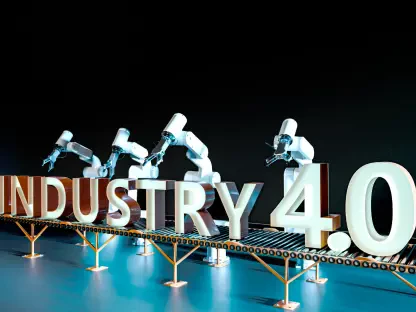In an era where digital connectivity underpins nearly every aspect of business and daily life, the challenge of managing increasingly intricate networks has become a pressing concern for enterprises worldwide, especially with the rapid proliferation of IoT devices. With the shift toward edge computing and the relentless surge of data traffic, traditional network management approaches often fall short, leading to costly downtime and inefficiencies. Enter agentic AI, a revolutionary technology that promises to redefine how networks are maintained through autonomous, self-healing capabilities. Unlike conventional AI systems bound by rigid programming, agentic AI operates with a level of independence, capable of reasoning, planning, and executing solutions in real time. This advancement is not just a step forward but a leap toward creating resilient, intelligent infrastructures that can adapt to challenges without human intervention. This exploration delves into the profound impact of agentic AI on network management, highlighting its transformative potential, real-world applications, and the hurdles that must be navigated to fully harness its power.
Unleashing Autonomy for Smarter Networks
The defining strength of agentic AI lies in its ability to transcend reactive responses and embrace proactive, independent decision-making in network environments. This technology continuously monitors data flows, identifies irregular patterns, and dynamically adjusts routing to prevent congestion, often before issues become apparent to human operators. By anticipating problems such as bandwidth limitations, agentic AI ensures seamless connectivity even under strain. Solutions like NetSynX from Persistent Systems exemplify this by automating complex network tasks with precision that surpasses manual efforts. Similarly, Ciena’s Navigator Network Control Suite leverages AI agents to optimize performance, demonstrating how autonomy translates into tangible operational gains. This shift toward self-governing systems marks a departure from traditional oversight, enabling networks to maintain stability in the face of unpredictable demands and paving the way for a new standard of efficiency.
Beyond merely solving immediate problems, agentic AI introduces a forward-thinking approach to network sustainability through continuous learning and adaptation. By analyzing historical data and current conditions, these systems refine their strategies over time, ensuring that each decision is more informed than the last. This iterative process not only minimizes disruptions but also reduces the burden on IT teams, allowing them to focus on strategic initiatives rather than firefighting routine issues. The implications are profound for industries reliant on constant uptime, such as telecommunications and e-commerce, where even brief outages can result in significant losses. As agentic AI evolves, its capacity to handle multi-layered network challenges autonomously positions it as an indispensable tool for modern enterprises striving to stay competitive in a hyper-connected landscape, redefining what it means to manage infrastructure effectively.
Tackling the Complexity of Digital Ecosystems
Modern networks are under unprecedented pressure due to the explosive growth of IoT devices and the demands of edge computing, creating a level of complexity that legacy systems struggle to address. These traditional setups often lack the agility required to operate at machine speed, leading to bottlenecks and vulnerabilities that can cripple operations. Industry leaders like Cisco emphasize that without reimagined architectures featuring ultra-low latency and integrated security, businesses risk being outpaced in a digital economy increasingly driven by AI. Projections suggest that AI agents could dominate enterprise traffic within the next few years, underscoring the urgency of adapting infrastructure to support such advanced technologies. Agentic AI steps in as a critical solution, offering the scalability and responsiveness needed to manage sprawling, dynamic networks effectively.
This technological shift also highlights a broader necessity for systemic upgrades to accommodate the capabilities of agentic AI in network management. The transition involves not just software enhancements but also significant investments in hardware and connectivity frameworks that can handle the computational intensity of autonomous systems. Without these foundational changes, the full potential of self-healing networks remains out of reach, leaving enterprises vulnerable to inefficiencies. The challenge is particularly acute for sectors managing vast data volumes, such as cloud service providers, where delays or failures can cascade across interconnected systems. By addressing these structural gaps, agentic AI paves the way for a future where networks are not just reactive but predictive, ensuring resilience against the growing intricacies of digital ecosystems and supporting the relentless pace of innovation.
Demonstrating Value Through Real-World Applications
Agentic AI is already proving its worth through practical implementations that deliver measurable benefits across diverse industries. In telecommunications, for instance, the technology automates service provisioning, slashing the time needed to deploy new connections and reducing human error in the process. Insights from IBM reveal how AI leverages historical data to optimize resource allocation, ensuring that network capacity aligns with demand patterns, which directly supports business objectives. These applications showcase the technology’s ability to transform theoretical concepts into actionable outcomes, enhancing operational efficiency in ways that were previously unattainable. The impact is evident in reduced costs and improved service reliability, which are critical for maintaining customer trust in competitive markets.
Equally significant is the potential for agentic AI to make advanced network management accessible to a wider range of organizations, not just industry giants. With inclusive design principles, as noted by tech analysts, smaller enterprises can adopt these tools without needing vast resources, leveling the playing field in digital infrastructure management. This democratization fosters innovation by enabling companies of varying sizes to harness self-healing networks, thereby enhancing their agility and responsiveness. From optimizing data centers to ensuring uninterrupted streaming services, the real-world impact of agentic AI underscores its role as a catalyst for progress. As adoption spreads, the technology is set to redefine benchmarks for performance, offering a glimpse into a future where network failures become a rarity rather than a recurring headache for businesses.
Addressing Barriers and Ethical Dilemmas
Despite its transformative potential, the integration of agentic AI into network management is not without significant challenges that require careful consideration. Scaling infrastructure to support such advanced systems often demands substantial capital for enhanced computing power and cutting-edge hardware, posing a barrier for many organizations. Security remains a critical concern as well; while AI can strengthen defenses by automating threat detection and response, its autonomous nature introduces risks of unintended actions. If an AI agent misroutes sensitive data or prioritizes efficiency over safety, determining accountability becomes a complex issue. These concerns highlight the need for robust frameworks to monitor and mitigate potential errors in real-time network operations.
Ethical considerations further complicate the deployment of agentic AI, as the balance between optimization and risk must be meticulously managed. Over-optimization, for instance, might inadvertently compromise security protocols, creating vulnerabilities that could be exploited. Industry discussions often point to the importance of establishing clear guidelines to govern AI behavior, ensuring that autonomous decisions align with organizational values and safety standards. Addressing these dilemmas requires not just technical solutions but also a commitment to transparency and oversight, so that trust in self-healing systems is maintained. As the technology advances, striking this balance will be essential to prevent misuse and to safeguard the integrity of networks that underpin critical services across sectors, from healthcare to finance.
Envisioning a Collaborative and Expansive Future
Looking ahead, the trajectory of agentic AI points toward its inevitable integration as a fundamental component of network management, promising self-healing systems that operate at unparalleled scales. Industry advocates, including major players like Cisco, promote a hybrid model where AI collaborates with human expertise, ensuring that automation enhances rather than replaces critical judgment. This balanced approach mitigates risks associated with full autonomy while capitalizing on AI’s speed and analytical prowess to handle routine tasks. Such collaboration is vital for sectors where oversight remains paramount, allowing for innovation without sacrificing control. The vision of intelligent, adaptive networks is fast becoming a reality, driven by this synergy between technology and human insight.
The influence of agentic AI extends beyond networking, with its principles inspiring advancements in diverse fields such as travel solutions and manufacturing processes. This cross-industry potential signals that autonomous, goal-oriented systems could become a bedrock of future business models, reshaping operational paradigms across the board. Investor enthusiasm, reflected in substantial funding for AI-driven initiatives, further fuels this momentum, indicating strong confidence in sustained growth. As applications expand, the focus must remain on strategic implementation that prioritizes resilience and scalability. The path forward involves not only embracing agentic AI’s capabilities but also fostering an environment where its benefits are accessible and its risks are diligently managed, setting the stage for a transformative era in digital infrastructure.
Reflecting on Milestones and Next Steps
Reflecting on the journey of agentic AI in network management, it becomes evident that this technology marks a turning point by enabling autonomous systems to predict and resolve issues with minimal oversight. Its practical applications, from telecom automation to resource optimization, deliver concrete value, while its potential to influence various industries hints at broader impacts. Challenges such as infrastructure costs, security risks, and ethical concerns are acknowledged as critical areas that demand attention during adoption. Moving forward, the emphasis should be on fostering hybrid models that blend AI efficiency with human guidance, ensuring balanced progress. Strategic investments and inclusive design must be prioritized to make self-healing networks widely accessible, while robust safeguards should be developed to address accountability gaps. By focusing on these actionable steps, the industry can unlock the full promise of agentic AI, building resilient digital ecosystems for the challenges ahead.









